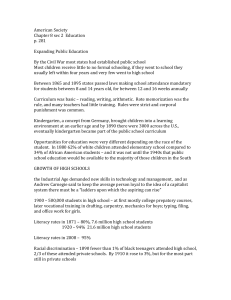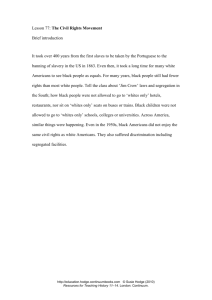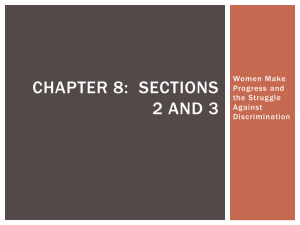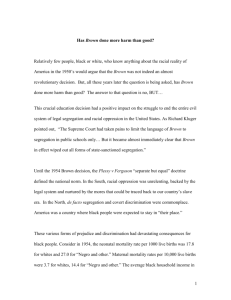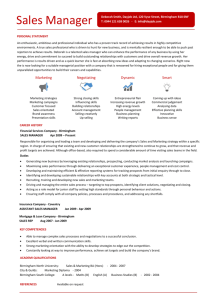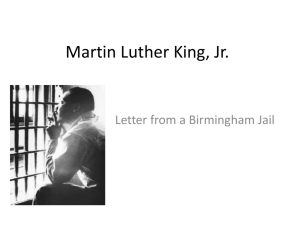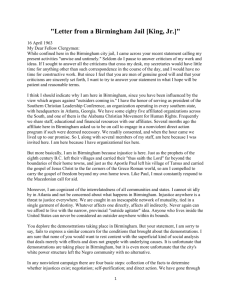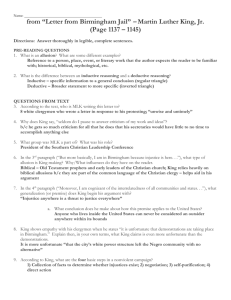Freedom Riders were civil rights activists who rode interstate buses
advertisement
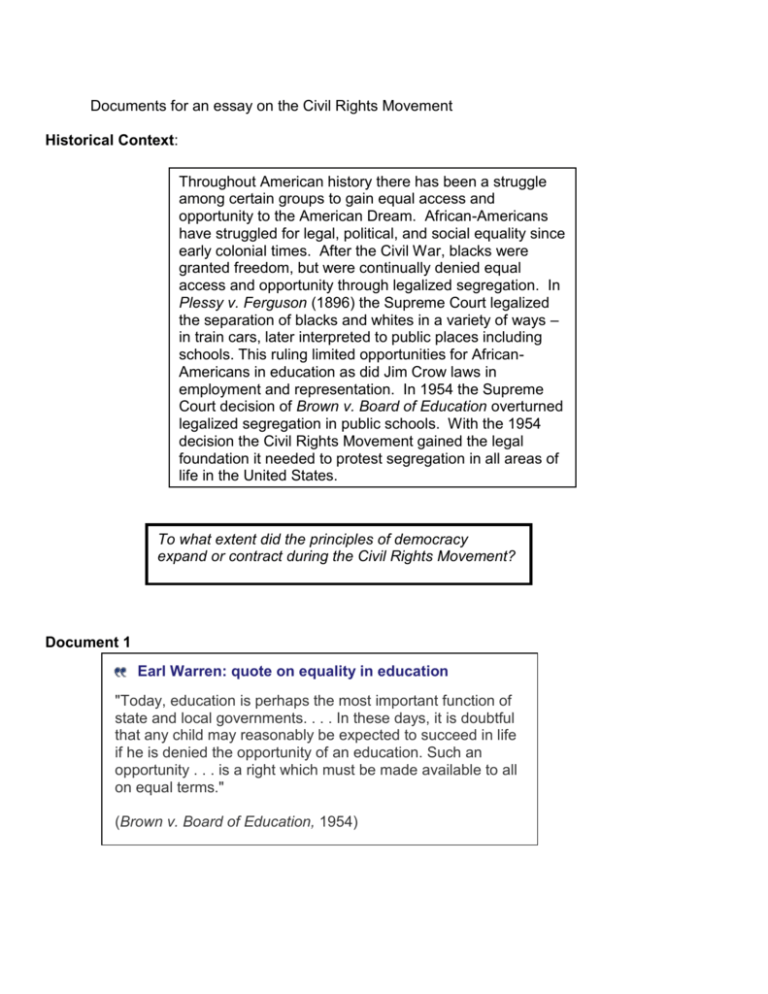
Documents for an essay on the Civil Rights Movement Historical Context: Throughout American history there has been a struggle among certain groups to gain equal access and opportunity to the American Dream. African-Americans have struggled for legal, political, and social equality since early colonial times. After the Civil War, blacks were granted freedom, but were continually denied equal access and opportunity through legalized segregation. In Plessy v. Ferguson (1896) the Supreme Court legalized the separation of blacks and whites in a variety of ways – in train cars, later interpreted to public places including schools. This ruling limited opportunities for AfricanAmericans in education as did Jim Crow laws in employment and representation. In 1954 the Supreme Court decision of Brown v. Board of Education overturned legalized segregation in public schools. With the 1954 decision the Civil Rights Movement gained the legal foundation it needed to protest segregation in all areas of life in the United States. To what extent did the principles of democracy expand or contract during the Civil Rights Movement? Document 1 Earl Warren: quote on equality in education "Today, education is perhaps the most important function of state and local governments. . . . In these days, it is doubtful that any child may reasonably be expected to succeed in life if he is denied the opportunity of an education. Such an opportunity . . . is a right which must be made available to all on equal terms." (Brown v. Board of Education, 1954) Document 2 School Integration in the American South, 1960 State Total Black Enrollment Integrated with "Whites" Alabama 267,259 0 Arkansas 104,205 98 Delaware 14,063 6,196 District of Columbia 89,451 73,290 Florida 201,091 512 Georgia 306,158 0 Kentucky 42,778 12,000 Louisiana 261,491 0 Maryland 130,076 28,072 Mississippi 271,761 0 82,000 35,000 302,060 34 39,405 10,246 South Carolina 255,616 0 Tennessee 146,700 169 Texas 279,374 3,300 Virginia 203,229 103 24,010 12,000 3,020,727 181,020 Missouri North Carolina Oklahoma West Virginia Total Document 3[Source: LunchCurrent, counter sit-in, Arlington, 1960 Courtesy Richmond Times-Dispatch Richard D., Harry Williams, and Frank Freidel, American History: A Survey, 1961.] Document 4 Image from incident the Freedom Riders Campaign: Freedom Riders were civil rights activists who rode interstate buses into the segregated southern United States in 1961 and following years to challenge the non-enforcement of the United States Supreme Court decisions Irene Morgan v. Commonwealth of Virginia (1946) and Boynton v. Virginia (1960), which ruled that segregated public buses were unconstitutional. The Southern states had ignored the rulings and the federal government did nothing to enforce them. The first Freedom Ride left Washington, D.C., on May 4, 1961, and was scheduled to arrive in New Orleans on May 17. This bus was attacked outside Montgomery by White racists. Document 5 Through it all, the most intolerable thing has been the campaign of ostracizing me (leaving a person out of all activities). It does not harm me directly. If anyone doesn’t want to associate with me, I’m sure that the feeling is at least mutual. I don’t think anyone should be forced to enter association with anyone else unless they so desire. However, the ostracizers not only don’t associate with me, but assume the right to see that no one else associates with me. If a white student sits down and drinks a cup of coffee with me, or walks with me across the campus, he is subjected to unhampered intimidation and harassment. I have been denied my privileges all along, but these whites have not been. Now they have lost a simple freedom. This sets back the Negro, because anytime you move backward, the person already down suffers more. This campaign, which apparently has been permitted to go on, really results in a reduction of everybody’s rights. James Meredith, First Negro admitted to University of Mississippi, 1963 I Can’t Fight Alone, James Meredith Document 6: Excerpt, "Letter from a Birmingham Jail," Martin Luther King, Jr., April 16, 1963. There can be no gainsaying the fact that racial injustice engulfs this community. Birmingham is probably the most thoroughly segregated city in the United States. Its ugly record of brutality is widely known. Negroes have experienced grossly unjust treatment in the courts. There have been more unsolved bombings of Negro homes and churches in Birmingham than in any other city in the nation. These are the hard, brutal facts of the case. On the basis of these conditions, Negro leaders sought to negotiate with the city fathers. But the latter consistently refused to engage in good-faith negotiation. Then, last September, came the opportunity to talk with leaders of Birmingham's economic community. In the course of the negotiations, certain promises were made by the merchants --- for example, to remove the stores humiliating racial signs. On the basis of these promises, the Reverend Fred Shuttlesworth and the leaders of the Alabama Christian Movement for Human Rights agreed to a moratorium on all demonstrations. As the weeks and months went by, we realized that we were the victims of a broken promise. A few signs, briefly removed, returned; the others remained. You may well ask: "Why direct action? Why sit-ins, marches and so forth? Isn't negotiation a better path?" You are quite right in calling, for negotiation. Indeed, this is the very purpose of direct action. Nonviolent direct action seeks to create such a crisis and foster such a tension that a community which has constantly refused to negotiate is forced to confront the issue. It seeks so to dramatize the issue that it can no longer be ignored. My citing the creation of tension as part of the work of the nonviolent-resister may sound rather shocking. But I must confess that I am not afraid of the word "tension." I have earnestly opposed violent tension, but there is a type of constructive, nonviolent tension which is necessary for growth. Document 7 Firefighters turn their hoses full force on civil rights demonstrators in Birmingham, Alabama on July 15, 1963 during protests that became a focal point of the desegregation movement. The Defenders Online ( NAACP publication) Document 8: The major sections [titles] of the Civil Rights Act of 1964 included these provisions: (1) Title I banned the use of different voter registration standards for blacks and whites. (2) Title II prohibited discrimination in public accommodations, such as motels, restaurants, gas stations, theaters, and sports arenas. (3) Title VI allowed the withholding of federal funds from public or private programs that practice discrimination. (4) Title VII banned discrimination on the basis of race, sex, religion, or national origin by employers and unions. (5) Title VII also created the Equal Employment Opportunity Commission (EEOC) to investigate charges of job discrimination. 4 Based on this document, state two provisions of the Civil Rights Act of 1964 that attempted Document 9: First march across the Edmund Pettus bridge out of Selma, AL was stopped by police. Sunday, March 7, 1965. Third march on March 21, made it all the way to Montgomery (the state capital): Document 10 (1) All citizens of the United States who are otherwise qualified by law to vote at any election by the people in any State, Territory, district, county, city, parish, township, school district, municipality, or other territorial subdivision, shall be entitled and allowed to vote at all such elections, without distinction of race, color, or previous condition of servitude; any constitution, law, custom, usage, or regulation of any State or Territory, or by or under its authority, to the contrary notwithstanding. Voting Rights Act (1965) Document 11 Stokely Carmichael: quote on Black Power "Black power . . . is a call for black people in this country to unite, to recognize their heritage, to build a sense of community." (Black Power, 1967) Document 12 (Your choice: one that you find relevant from the period 1965 to 1968)
